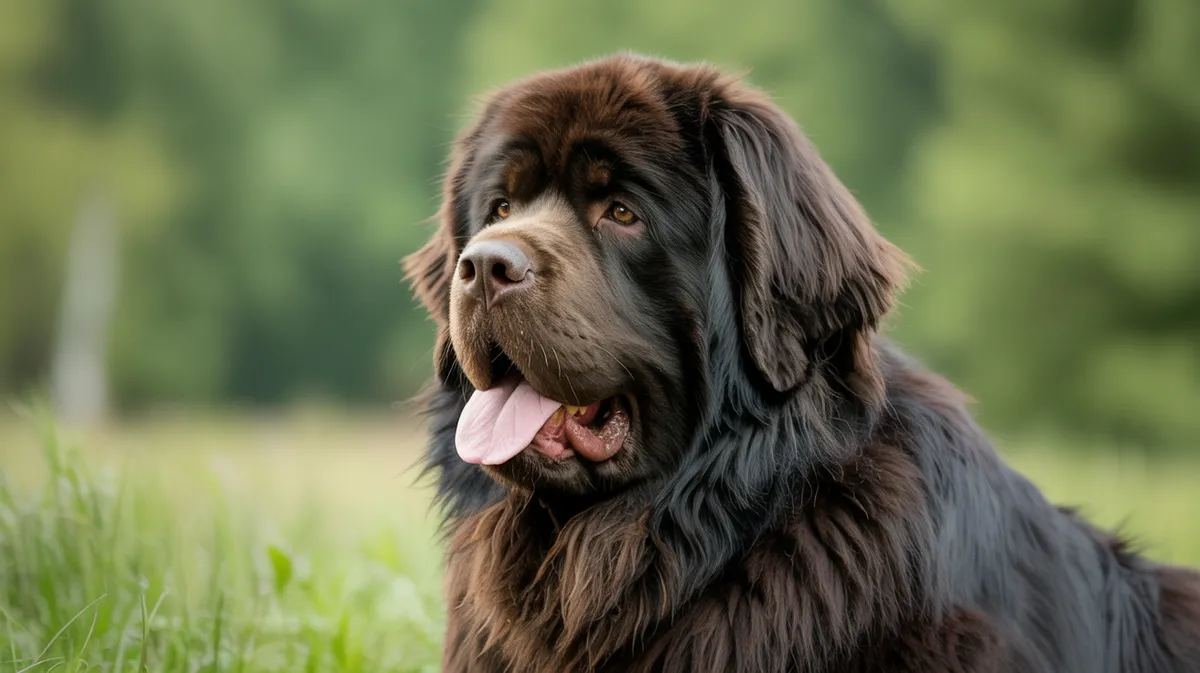
Newfoundland Dog
Canis lupus familiaris

Meet the Newfoundland Dog
The Newfoundland is a large working dog breed originally bred for life-saving water rescues in the cold North Atlantic. Known for its massive size, thick double coat, and gentle temperament, the breed is especially renowned for its swimming ability and strength. Newfoundlands are highly trainable, loyal, and affectionate, making them excellent family companions as well as working dogs. Their calm demeanor and patience with children have earned them the nickname 'gentle giants.'
Classification
Mammal
Habitat
Domestic
Diet
Omnivore
Lifespan
8-10 years
Conservation
Least Concern
Weight
100–150 lbs (45–68 kg)
📖Fascinating Facts
Webbed Feet
Newfoundlands have unique, webbed feet that help them swim powerfully and efficiently in water.
Lifesaving Instinct
The breed has a strong instinct to rescue drowning people, making them famous water rescue dogs.
Gentle Giant
Despite their large size, Newfoundlands are known for their docile and patient nature, especially around children.
📋Detailed Description
The Newfoundland Dog is a giant breed, with adult males typically weighing between 60–70 kg (132–154 lbs) and standing 71 cm (28 in) at the shoulder, while females are slightly smaller. Their broad, muscular build is complemented by a dense, water-resistant double coat and webbed feet, both adaptations for aquatic work. The head is massive with a pronounced occiput, deep muzzle, and expressive, dark brown eyes that convey a gentle disposition. Newfoundlands are renowned for their calm, patient, and nurturing temperament, making them exceptional therapy and assistance dogs. Social by nature, they thrive in family environments and display strong bonds with both humans and other animals. Their behavior is characterized by a low prey drive and a tendency to be protective without aggression. The breed is highly intelligent and responds well to positive reinforcement training, excelling in tasks that require problem-solving and teamwork. Newfoundlands are slow to mature, both physically and mentally, often retaining puppy-like behaviors into their second or third year. They are known for their remarkable stamina and endurance in water, historically performing lifesaving rescues and hauling heavy loads. Lifespan averages 8–10 years, with health concerns including hip and elbow dysplasia, cardiac issues, and cystinuria.
💡 Did you know?
Newfoundlands have been credited with saving hundreds of lives due to their powerful swimming and life-saving instincts.
🔬Research & Sources
🎭Behavior & Social Structure
Newfoundlands exhibit a docile and even-tempered demeanor, rarely showing signs of anxiety or aggression. They are highly social, preferring to remain close to their human family and often following them from room to room. Playful yet gentle, they are particularly tolerant of children and smaller animals. Their feeding behavior is typical of large breeds, requiring a balanced omnivorous diet with controlled portions to prevent obesity. Newfoundlands are not natural hunters; instead, their instincts are oriented toward rescue and assistance, often displaying a tendency to 'herd' or watch over people and animals. They are most active during cooler parts of the day, as their thick coats make them prone to overheating. Daily routines include moderate exercise, such as swimming or walking, and they benefit from mental stimulation through training or interactive play. Barking is infrequent but deep and resonant, typically used to alert rather than to intimidate.
👶Reproduction & Life Cycle
Newfoundlands reach sexual maturity between 18–24 months. The breed is monoestrous, with females coming into heat approximately twice a year. Mating is typically managed by breeders to prevent hereditary health issues. The gestation period averages 63 days, after which litters of 6–12 puppies are born. Neonates are altricial, requiring intensive maternal care; mothers are attentive, providing warmth, grooming, and nursing. Weaning begins at 3–4 weeks, with puppies transitioning to solid food by 6–8 weeks. Socialization during early development is critical to ensure stable adult temperaments. Responsible breeders screen for genetic disorders, particularly hip dysplasia and cystinuria, to maintain breed health.
🛡️Adaptations & Survival
The Newfoundland's most distinctive adaptation is its suitability for aquatic environments. The breed possesses a thick, oily double coat that insulates against cold water and repels moisture. Their large, webbed paws function as natural paddles, enabling efficient swimming and maneuverability. A powerful, muscular neck and broad chest facilitate towing and lifesaving tasks. The tail is long and strong, acting as a rudder during swimming. Behaviorally, Newfoundlands are predisposed to rescue behaviors, including a unique swimming stroke (the 'down and out' stroke) that maximizes propulsion. Their calm temperament and high pain threshold are advantageous in stressful rescue scenarios.
📚Research Sources
🎨Cultural Significance
The Newfoundland Dog holds a prominent place in maritime history and folklore, especially in Newfoundland and Labrador, Canada, where it is the official provincial animal. Revered for its lifesaving abilities, the breed has been credited with numerous water rescues, inspiring stories, and memorials. Notable historical figures, including Sir Edwin Landseer, have immortalized the breed in art—so much so that the black-and-white variant is sometimes called the 'Landseer.' Newfoundlands have appeared in literature, such as J.M. Barrie's 'Peter Pan,' where the dog Nana is modeled after the breed. They symbolize loyalty, strength, and gentleness, and have served as mascots for lifeguard organizations and the Royal Canadian Mounted Police.
🔬Recent Research & Discoveries
Recent genetic studies have explored the Newfoundland's ancestry, confirming close relationships with other North Atlantic working breeds such as the Labrador Retriever and the now-extinct St. John's Water Dog. Ongoing research focuses on the genetic basis of hereditary diseases, particularly cystinuria and cardiac conditions, with the aim of developing better screening and management protocols. Studies on canine aquatic locomotion have highlighted the Newfoundland's unique swimming mechanics and endurance. Behavioral research has underscored the breed's suitability for therapy and assistance roles, with ongoing trials in animal-assisted interventions for children and the elderly. Advances in veterinary orthopedics are improving outcomes for common musculoskeletal disorders in the breed.
🎥Wildlife Videos

Wildlife - Just Wild Dogs | Free Documentary Nature
Wildlife - Episode 7: Just Wild Dogs | Wildlife Documentary Watch 'Wildlife - Episode 8' here: https://youtu.be/kglJpB4ei8o Run ...
Free Documentary - Nature

Dogs 101: Newfoundland
Watch More At: http://animal.discovery.com/videos/dogs-101-season-one/?smid=YTAPC-YTD-PLP Newfoundland is the most ...
Animal Planet

Man's First Friend - The Epic Story of Dogs & Humans | Free Documentary Nature
Man's First Friend - Ths History of Dogs & Humans | Nature Documentary Watch 'Wildlife - Just Wild Dogs' here: ...
Free Documentary - Nature

Newfoundland - On the Shores of Canada's Most Spectacular Coast | Free Documentary Nature
Newfoundland - On the Shores of Canada's Most Spectacular Coast | Nature Documentary Watch 'Alaska - The Last Frontier' ...
Free Documentary - Nature

THE NEWFOUNDLAND DOG - WORLD'S MOST POWERFUL WATER DOG
Forget Baywatch and lifeguards, meet The Newfoundland, Canada's most powerful, ultimate water dog - Bred to pull boats in to ...
Animal Watch

Wolves of Labrador | Great Migration of the George River Caribou | Wolf Documentary | Canada Wild 🇨🇦
On Canada's most inhospitable coast, a remarkable story unfolds. Follow the "Wolves of Labrador" as they navigate this unknown, ...
Canada Wild 🇨🇦
🌍Habitat Information
The Newfoundland Dog typically inhabits Domestic environments. Newfoundland Dogs have adapted to their environments with specialized features and behaviors.
Primary Habitat:
Domestic
More detailed habitat information will be available soon.
🛡️Conservation Status
The Newfoundland Dog is currently classified as Least Concern. Conservation efforts are crucial for preserving this species for future generations.
Common Threats:
- 🏠Habitat loss and fragmentation
- 🌡️Climate change impacts
- 🎯Hunting and poaching
- 🏭Human-wildlife conflict
⚠️Threats & Conservation Challenges
As a domestic breed, Newfoundlands are not threatened in the wild, but they face challenges related to health and welfare. Common threats include hereditary diseases such as hip and elbow dysplasia, subvalvular aortic stenosis (SAS), and cystinuria. Obesity is a significant risk due to their large size and relatively low activity levels in modern settings. Unscrupulous breeding practices can exacerbate genetic problems. Climate change and urbanization have reduced opportunities for traditional working roles, potentially impacting mental and physical health. Responsible ownership, health screening, and breed-specific education are essential for maintaining population health. The breed remains popular in North America and Europe, with stable population trends.
🔬Scientific Classification
Scientific Name
Canis lupus familiaris
Classification Hierarchy
🔍 About Taxonomic Classification
Taxonomic classification is a hierarchical system used by scientists to classify and organize living organisms based on shared characteristics and evolutionary relationships.
The system moves from broad categories (Kingdom) to increasingly specific ones, with each animal's scientific name typically consisting of its Genus and species.
📝Community Notes
Share your observations and insights about the Newfoundland Dog with our community of wildlife enthusiasts.
Join Our Community
Sign in to share your observations and connect with fellow wildlife enthusiasts.
Sign In to ContributeNo community notes yet
Be the first to share your observations about the Newfoundland Dog!
Explore Newfoundland Dog
Select a tab above to learn more about this amazing animal.
📸Photo Gallery
No photos available for this animal yet.
🌟Discover More Wildlife
Continue your journey of discovery with more fascinating animals from our database
